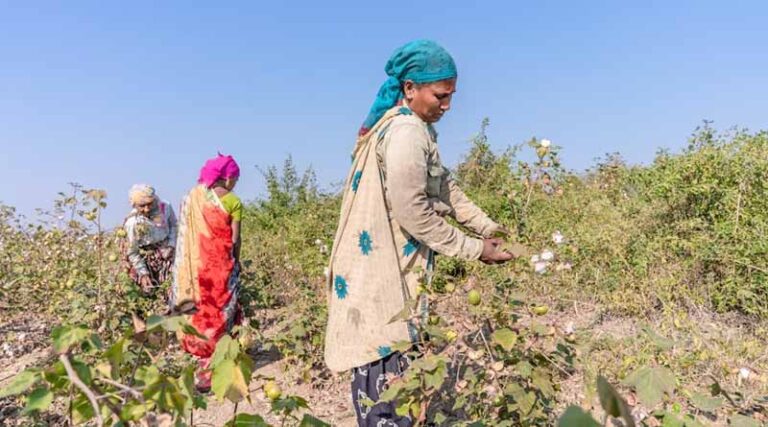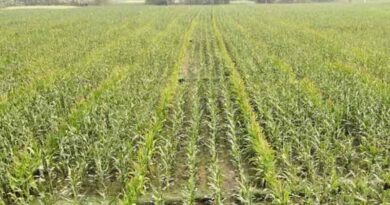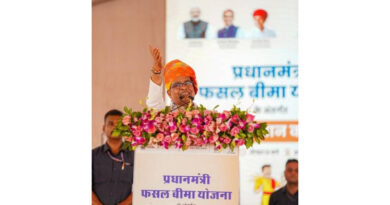
Kharif Crop Sowing in India Exceeds Last Year’s Area Coverage, Reaching 1121.46 Lakh Hectares
07 October 2025, New Delhi: The Ministry of Agriculture and Farmers’ Welfare has reported that the total area sown under Kharif crops in India has reached 1121.46 lakh hectares as on October 3, 2025 — surpassing last year’s coverage of 1114.95 lakh hectares. The overall increase of 6.51 lakh hectares, representing a 0.6% rise over the previous Kharif season, reflects resilience and strong farmer participation despite varying monsoon conditions across regions.
According to the data released by the Department of Agriculture & Farmers’ Welfare, several major crops including rice, pulses, maize, and sugarcane have shown significant area expansion this season, with maize recording the highest increase among cereals. The improvement in sowing figures suggests a positive outlook for Kharif 2025-26, bolstered by supportive government policies, timely rainfall, and enhanced seed and input distribution at the state level.
Rice: Steady Expansion Amid Good Monsoon Coverage
Rice remains the dominant Kharif crop, covering 441.58 lakh hectares this season compared to 435.68 lakh hectares last year — an increase of 5.9 lakh hectares or 1.35% growth. This expansion has been particularly visible in eastern and southern states such as Odisha, Chhattisgarh, Andhra Pradesh, and Tamil Nadu, where monsoon distribution remained stable. Improved availability of high-yielding paddy varieties and timely transplantation contributed to this growth. With stable procurement policies under the MSP system, farmers have shown confidence in maintaining and even expanding paddy acreage.
Pulses: Marginal Rise Driven by Tur and Urad
The total area under pulses has reached 120.41 lakh hectares, slightly higher than 119.04 lakh hectares last year — a growth of 1.15%. Within the category, tur (arhar) has shown marginal improvement, increasing to 46.60 lakh hectares, while urad area rose sharply to 24.37 lakh hectares from 22.87 lakh hectares, a 6.6% growth. However, moong and moth bean areas saw minor reductions. The overall improvement indicates consistent efforts by farmers to maintain pulse acreage in response to government push for self-sufficiency and better market prices.
Coarse Cereals: Strong Surge Led by Maize
Coarse cereals have registered a sharp rise in area coverage, from 183.54 lakh hectares last year to 194.67 lakh hectaresthis year — an increase of 11.13 lakh hectares (6.06%). The standout performer is maize, which alone saw an increase of 10.65 lakh hectares, expanding from 84.30 lakh hectares to 94.95 lakh hectares, reflecting a growth of 12.6%. This significant gain is attributed to maize’s rising demand for both ethanol and the poultry feed industry along with strong seed availability and good returns compared to other coarse grains. States like Karnataka, Madhya Pradesh, Bihar, and Maharashtra have driven this expansion.
Oilseeds: Contraction Due to Reduced Soybean and Groundnut Sowing
The oilseed segment witnessed a reduction this season, covering 190.13 lakh hectares against 200.75 lakh hectares last year, marking a decline of 10.62 lakh hectares (-5.3%). The primary reason for this contraction was the lower acreage under soybean, which dropped to 120.45 lakh hectares from 129.55 lakh hectares, a 7% fall. Similarly, groundnut area fell marginally by 3.2%, and sesamum also recorded a small dip. This reduction may be linked to delayed monsoon onset in soybean belts of Madhya Pradesh and Maharashtra and a shift by farmers toward maize and pulses, which offered better price stability this season.
Sugarcane: Continued Expansion on Strong Price Outlook
Sugarcane area rose to 59.07 lakh hectares, up from 57.22 lakh hectares last year, marking a growth of 3.25%. Consistent water availability, remunerative returns under the Fair and Remunerative Price (FRP), and strong demand from sugar mills have encouraged farmers, particularly in Uttar Pradesh, Maharashtra, and Karnataka, to increase their sugarcane acreage.
Jute and Mesta: Minor Reduction
Jute and mesta crops have seen a marginal decline in sown area, falling to 5.56 lakh hectares from 5.75 lakh hectareslast year, reflecting a 3.3% decrease. This dip is largely due to shifting weather patterns in the eastern belt and farmers moving towards paddy and maize cultivation in flood-affected regions of West Bengal and Assam.
Cotton: Marginal Contraction in Acreage
Cotton acreage stands at 110.03 lakh hectares, compared to 112.97 lakh hectares last year, a reduction of 2.6%. Uncertain rainfall during the early sowing window in parts of Gujarat and Telangana led to farmers shifting partially towards pulses and coarse cereals. However, overall cotton conditions remain healthy, and crop establishment in major producing states is satisfactory.
Kharif Crop Area Coverage in India (as on 3rd October 2025)
| S.No. | Crop / Sub-crop | Normal Area (2019–20 to 2023–24) | 2025–26 | 2024–25 | Increase (+) / Decrease (–) | % Change Over 2024–25 |
|---|---|---|---|---|---|---|
| 1 | Rice | 403.09 | 441.58 | 435.68 | +5.90 | +1.35% |
| 2 | Pulses (Total) | 129.61 | 120.41 | 119.04 | +1.37 | +1.15% |
| 2(a) | Tur (Arhar) | 44.71 | 46.60 | 46.45 | +0.15 | +0.32% |
| 2(b) | Kulthi (Horse Gram) | 1.72 | 0.72 | 0.56 | +0.16 | +28.6% |
| 2(c) | Urad (Black Gram) | 32.64 | 24.37 | 22.87 | +1.50 | +6.56% |
| 2(d) | Moong (Green Gram) | 35.69 | 34.87 | 34.96 | –0.09 | –0.26% |
| 2(e) | Other Pulses | 5.15 | 4.62 | 4.58 | +0.05 | +1.09% |
| 2(f) | Moth Bean | 9.70 | 9.24 | 9.63 | –0.39 | –4.05% |
| 3 | Coarse Cereals (Total) | 180.71 | 194.67 | 183.54 | +11.13 | +6.06% |
| 3(a) | Jowar | 15.07 | 14.07 | 14.21 | –0.14 | –0.99% |
| 3(b) | Bajra | 70.69 | 68.44 | 68.65 | –0.21 | –0.31% |
| 3(c) | Ragi | 11.52 | 11.81 | 11.96 | –0.15 | –1.25% |
| 3(d) | Maize | 78.95 | 94.95 | 84.30 | +10.65 | +12.63% |
| 3(e) | Other Small Millets | 4.48 | 5.39 | 4.42 | +0.97 | +21.95% |
| 4 | Oilseeds (Total) | 194.63 | 190.13 | 200.75 | –10.62 | –5.29% |
| 4(a) | Groundnut | 45.10 | 48.36 | 49.96 | –1.60 | –3.20% |
| 4(b) | Sesamum (Til) | 10.32 | 10.51 | 11.07 | –0.56 | –5.06% |
| 4(c) | Sunflower | 1.29 | 0.71 | 0.73 | –0.02 | –2.74% |
| 4(d) | Soybean | 127.19 | 120.45 | 129.55 | –9.10 | –7.03% |
| 4(e) | Niger Seed | 1.08 | 1.04 | 0.98 | +0.06 | +6.12% |
| 4(f) | Castor Seed | 9.65 | 8.98 | 8.39 | +0.60 | +7.15% |
| 4(g) | Other Oilseeds | 0.00 | 0.08 | 0.08 | 0.00 | 0.00% |
| 5 | Sugarcane | 52.51 | 59.07 | 57.22 | +1.86 | +3.25% |
| 6 | Jute & Mesta | 6.60 | 5.56 | 5.75 | –0.18 | –3.30% |
| 7 | Cotton | 129.50 | 110.03 | 112.97 | –2.94 | –2.60% |
| — | Total Kharif (All Crops) | 1096.65 | 1121.46 | 1114.95 | +6.51 | +0.58% |
Balanced Crop Diversification
The 2025–26 Kharif season reflects a balanced agricultural landscape in India, with increased total sowing indicating steady farmer confidence and effective implementation of agri-support programs. The massive loss of crops across Maharashtra, Punjab and Madhya Pradesh due to floods is yet to be assessed and will reduce the sowing acreages and may also affect production target for the year. Meanwhile, the marginal contraction in oilseed and cotton acreage highlights the need for continued government interventions in promoting diversification and value-chain support for oilseed crops.
Also Read: John Deere Introduces the Z370RS Electric ZTrak™ Mower Featuring EGO 56V ARC Lithium™ Batteries
📢 If You’re in Agriculture, Make Sure the Right People Hear Your Story.
From product launches to strategic announcements, Global Agriculture offers unmatched visibility across international agri-business markets. Connect with us at pr@global-agriculture.com to explore editorial and advertising opportunities that reach the right audience, worldwide.






